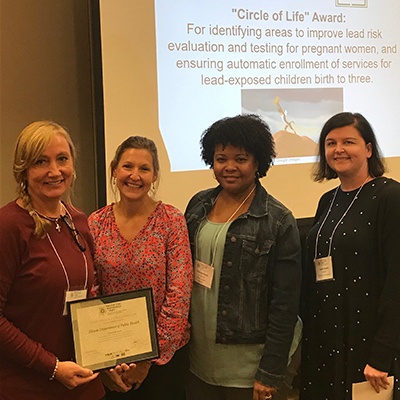
Aim
- Develop a plan to reduce lead-related morbidity in infant and toddlers by developing policies, procedures, and resources for maternal health care providers and pregnant mothers that target increased identification, management, and education.
- Decrease by 10% the number of elevated blood lead levels (EBLLs) in children less than 6 years of age by August 2020.
- Increase by 25% the number of children less than 6 years of age who receive a blood lead level (BLL) screening by August 2020.
The Illinois team was successful in achieving their first two aims. However, due to the COVID-19 pandemic, they did not achieve their third aim during the Maternal and Child Environmental Health Collaborative Improvement and Innovation Network (MCEH CoIIN) project period.

Results
Data Resources
- Created an interactive map that shows 2017 surveillance data of identified
lead-exposed children. The map is updated as new data becomes available.
Guidelines and Recommendations
- Surveyed OB-GYNs to identify areas to improve the guidelines on lead risk evaluation and testing and medical management for pregnant women, including the Prenatal Lead Risk Questionnaire (PLRQ) and algorithm. The team updated the guidance and identified areas to improve provider education and training.
- Updated the Childhood Lead Risk Questionnaire (CLRQ) and algorithm and created Infant and Childhood Evaluation and Testing Recommendations.
Education, Training, and Outreach
- Developed educational materials and trainings for providers on confirmatory/follow-up testing intervals and common errors in BLL testing and reporting, which included trainings for the Illinois State Medical Society and case management nurses.
- Developed a booklet with comprehensive information for families of lead-exposed children and a cleaning checklist to reduce lead exposure.
- Contacted business managers and staff of health care providers in target areas via email and phone to provide information on lead poisoning prevention and screening.
- Developed a new lead poisoning prevention poster for hardware stores.
- Collaborated with the Illinois Adult Lead Blood Program and obtained authorization to use their brochures to educate families with lead-exposed children and licensed lead abatement professionals.
- Provided child lead evaluation/testing and education at the Illinois State Fair.
Policies and Procedures
- On January 15, 2019, the state of Illinois approved rules to lower the level at which public health interventions are initiated for children with EBLLs from 10 micrograms per deciliter (μg/dL) to the Centers for Disease Control and Prevention reference level of 5 μg/dL. This means more children will be identified as having lead poisoning, which allows parents, doctors, public health officials, and communities to act earlier to reduce the child’s future exposure to lead.
- Public Act 101-0010 was passed in Illinois. An amendment to the Early Intervention Service System Act ensures automatic eligibility for children ages 0 through 3 who have been lead poisoned (confirmed EBLLs greater than or equal to 5 µg/dL).

Resources
- Childhood Blood Level Evaluation and Testing Recommendations
- Childhood Lead Risk Assessment Questionnaire (CLRQ)
- CLRQ Algorithm
- Updated Prenatal Lead Risk Questionnaire (PLRQ)
- PLRQ Algorithm
- Lead and Pregnancy: Keep Your Baby Safe (poster) (Spanish version)
- Physician testing handout (Spanish version)
- Keep Your Kids Safe and Get Them Tested for Lead! (poster)
- Reorganized Lead Program website
- Childhood lead poisoning prevention map
- Illinois Department of Public Health evaluation and testing recommendations for pre-conceptual counseling, pregnancy, and breastfeeding
- Updated Public Health Nurse Form for Lead Assessment
- Follow-up testing letter
- Lead in Drinking Water (fact sheet)
- OB/GYN CoIIN Survey
- Lead Poisoning and Pregnancy: Understanding Risks and Preventing Harm (PowerPoint presentation with voiceover – contact the Illinois team for more information about this resource)
- Hardware Store Poster (waiting for approval to publish – contact the Illinois team for more information about this resource)
- Cleaning Checklist (waiting for approval to publish – contact the Illinois team for more information about this resource)
- Pregnancy magnet
- Education web series magnet
- Lead Exposure and Impacts on Early Brain Development (Association of State and Territorial Health Officials webinar featuring the Illinois MCEH CoIIN team)
Click here to view the full change package of strategies and actions that Illinois used as they worked to achieve their aims as part of the MCEH CoIIN.

Contact

Contact the Illinois Team:
https://www.dph.illinois.gov/illinoislead
Darla Hamende, 217-558-2611


